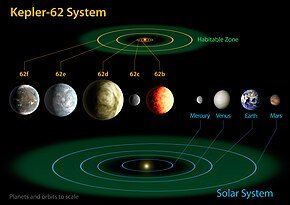2013: The Discovery of Two Earth-Like Planets
On April 18, 2013, astronomers made a groundbreaking announcement that captured the attention of the scientific community and the general public alike. They revealed the discovery of two earth-like planets orbiting the star Kepler-62, located in the star’s habitable zone. These planets, named Kepler-62e and Kepler-62f, offered the tantalizing possibility of hosting liquid water and, consequently, the potential for life to exist.
The discovery of these two planets was made possible through the use of NASA’s Kepler Space Telescope. This remarkable instrument was designed to search for planets beyond our solar system by detecting slight changes in brightness caused by planets passing in front of their host stars. By carefully analyzing the data collected by the telescope, astronomers were able to identify the presence of these two earth-like planets.
Kepler-62e and Kepler-62f are situated at a distance of approximately 1,200 light-years from Earth. Both planets have a size similar to that of Earth, making them prime candidates for further investigation. Moreover, their location within the habitable zone of their star means that they receive an amount of energy from their star that could potentially support the existence of liquid water on their surfaces.
The discovery of these two earth-like planets was a significant milestone in the field of exoplanet research. It provided valuable insights into the prevalence of potentially habitable planets in the universe and sparked a renewed interest in the search for extraterrestrial life. The tantalizing possibility that there may be other worlds out there capable of supporting life as we know it captured the imagination of people worldwide.
The Kepler Space Telescope, launched by NASA in 2009, played a crucial role in this groundbreaking discovery. Its primary mission was to determine the frequency of earth-like planets in our galaxy. By continuously monitoring the brightness of over 150,000 stars in a specific region of the sky, Kepler provided astronomers with an unprecedented amount of data to analyze.
The discovery of Kepler-62e and Kepler-62f was not only a testament to the capabilities of the Kepler Space Telescope but also a testament to the dedication and expertise of the astronomers involved in the project. The painstaking analysis of the telescope’s data, combined with the use of sophisticated algorithms, allowed them to identify the subtle signals indicating the presence of these two planets.
The discovery of these two earth-like planets also raised intriguing questions about the potential for life beyond our solar system. While the presence of liquid water is a critical factor in the search for habitable environments, it is just one piece of the puzzle. Many other factors, such as the composition of the atmosphere and the presence of organic molecules, must also be considered.
In the years since this groundbreaking discovery, astronomers have continued to search for earth-like planets in the habitable zones of other stars. The ongoing advancements in technology and the development of more powerful telescopes have greatly enhanced our ability to detect and study these distant worlds. Each new discovery brings us closer to answering the age-old question: Are we alone in the universe?
In conclusion, the discovery of Kepler-62e and Kepler-62f in 2013 marked a significant milestone in our understanding of the potential for habitable planets beyond our solar system. The use of NASA’s Kepler Space Telescope allowed astronomers to detect these two earth-like planets and provided valuable insights into the prevalence of such planets in the universe. While the search for extraterrestrial life continues, this discovery fueled scientific and public intrigue, igniting our imagination and pushing the boundaries of our knowledge about the cosmos.
SEO Keywords: 2013 two earth-like planets discovered, 18th April 2013 two earth-like planets discovered
SEO Excerpt: On April 18, 2013, astronomers announced the discovery of two earth-like planets orbiting the star Kepler-62. This groundbreaking discovery, made using NASA’s Kepler Space Telescope, provided significant insights into the potential for other habitable planets in the universe and fueled scientific and public intrigue about the possibility of extraterrestrial life.

